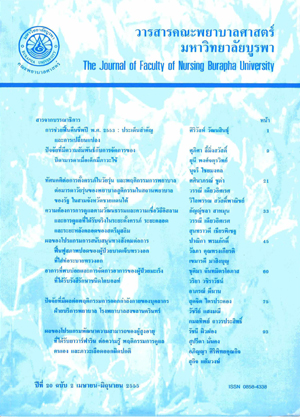การช่วยฟื้นคืนชีพปี พ.ศ.2553: ประเด็นสำคัญและการเปลี่ยนแปลง
คำสำคัญ:
ภาวะหัวใจหยุดเต้น, การช่วยฟื้นคืนชีพ, ภาวะฉุกเฉินระบบหัวใจและหลอดเลือด, Cardiac arrest, cardiopulmonary resuscitation, emergency cardiovascular careบทคัดย่อ
แนวทางปฏิบัติการช่วยฟื้นคืนชีพและการช่วยเหลือในภาวะฉุกเฉินระบบหัวใจและหลอดเลือดปี พ.ศ.2553 เป็นผลจากการประชุมนานาชาติเกี่ยวกับการช่วยฟื้นคืนชีพของสมาคมแพทย์โรคหัวใจแห่งสหรัฐอเมริกา ประกอบด้วยผู้เชี่ยวชาญ ผู้ทรงคุณวุฒิจำนวนมากจากนานาชาติมาประชุมร่วมกับคณะกรรมการของสมาคมฯ ร่วมกันวิเคราะห์ อภิปรายและพิจารณาให้ข้อสรุปจากการศึกษางานวิจัยที่สนับสนุนการช่วยฟื้นคืนชีพ การทบทวนหลักฐานที่น่าเชื่อถือ รวมทั้งสืบค้นเพิ่มเติมแล้วนำมาเสนอเป็นแนวทางปฏิบัติการช่วยฟื้นคืนชีพและการช่วยเหลือในภาวะฉุกเฉิน โดยมีประเด็นสำคัญที่เปลี่ยนแปลงไปจากแนวทางปฏิบัติการช่วยฟื้นคืนชีพปี พ.ศ.2548ดังนี้
1. ใช้ขั้นตอนการช่วยฟื้นคืนชีพขั้นพื้นฐาน C-A-B แทน A-B-C คือกดหน้าอก เปิดทางเดินหายใจ 30 ครั้ง และช่วยหายใจ 2 ครั้ง ทั้งในผู้ใหญ่และเด็กอายุ 1-8 ปี เด็กทารกอายุต่ำกว่า 1 ปี (ยกเว้นทารกแรกเกิดยังคงใช้ A-B-C) เมื่อพบผู้ป่วยหมดสติ ไม่หายใจหรือหายใจไม่ปกติ เช่น หายใจเฮือกให้สงสัยว่าผู้ป่วยเกิดภาวะหัวใจหยุดเต้น โทรตามหน่วยกู้ชีพและเริ่มต้นช่วยฟื้นคืนชีพทันที
2. ยกเลิกการดู การฟัง ความรู้สึกลมผ่านแก้ม การตรวจจับชีพจรสำหรับบุคลากรทางการแพทย์ไม่ควรใช้เวลาเกิน 10 วินาที ถ้าคลำไม่ได้ภายใน 10 วินาที ให้เริ่มต้น CPR ทันที และใช้เครื่องช็อกไฟฟ้าอัตโนมัติ (automated external defibrillator: AED) เมื่อเครื่องพร้อม
3. เน้นการกดหน้าอกอย่างมีคุณภาพโดยกดแรงและเร็ว
4. แนะนำให้ใช้กราฟแสดงค่าคาร์บอนไดออกไซด์จากลมหายใจออก (continuous waveform capnography) ในผู้ป่วยที่ใส่ท่อช่วยหายใจระหว่างการช่วยฟื้นคืนชีพเพื่อยืนยันตำแหน่งท่อช่วยหายใจ และ ประเมินประสิทธิภาพการช่วยฟื้นคืนชีพ
5.แผนปฏิบัติการการช่วยฟื้นคืนชีพขั้นสูงไม่แนะนำให้ใช้ยาอะโทรปีน (Atropine) อีก แนะนำให้ใช้ยาอะดีโนซีน (Adenosine) ในการรักษาภาวะหัวใจเต้นเร็วผิดปกติที่มีคลื่น QRS complexกว้างจังหวะหัวใจเต้นสม่ำเสมอ (regular wide QRS complex tachycardia)
The 2010 American Heart Association Guidelines for Cardiopulmonary Resuscitation (CPR) and Emergency Cardiovascular Care (ECC) are base on an international evidence evaluation process that involve the international resuscitation scientists and experts who evaluates, discussed and debated the peer reviewed publications. The key issues and major changes from the 2005 AHA Guidelines for CPR and ECC recommendations for health care providers include the following
1. The sequence of CPR for adults, children and infants began with C-A-B (Chest compressions, Airway, Breathing) (excluding the neonatal CPR began with A-B-C).Beginning CPR with 30 compressions rather than 2 ventilations lead to the shorter delay to first compression. Immediate recognition of cardiac arrest and activation of the emergency response system base on sigh of unresponsive with no breathing or no normal breathing (i.e. victims only gasping).
2. Looks, Listen and Feel for breathing has been remove from the algorithm.
The healthcare provider should not spend more than 10 seconds check for a pulse, and if a pulse is not definitely felt within 10 seconds, should begin CPR and use the automated external defibrillator (AED) when available.
3. Continues emphasis on high quality chest compression.
4. Qualitative waveform capnography is recommended for confirmation and monitoring of endotracheal tube placement and CPR quality.
5. Atropine has been removed from the ACLS Cardiac Arrest Algorithm. Adenosine is recommended in the initial diagnosis and treatment of stable, regular wide QRS complex tachycardia.





